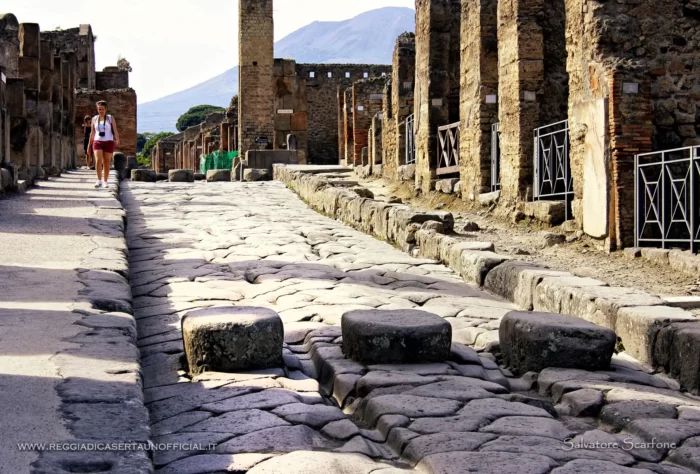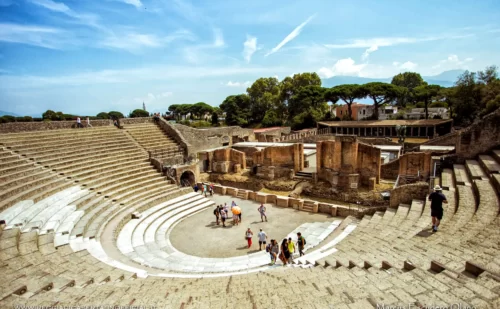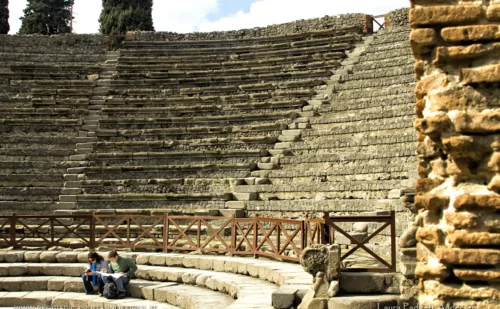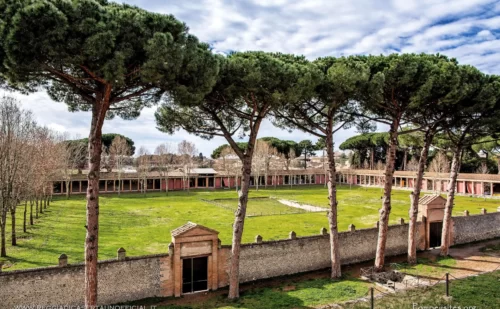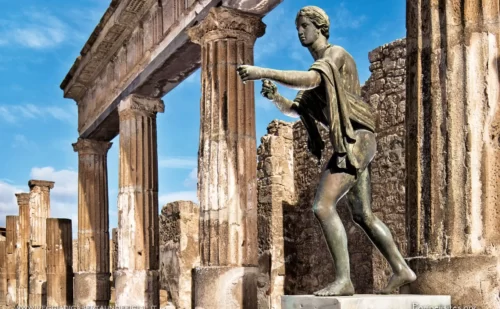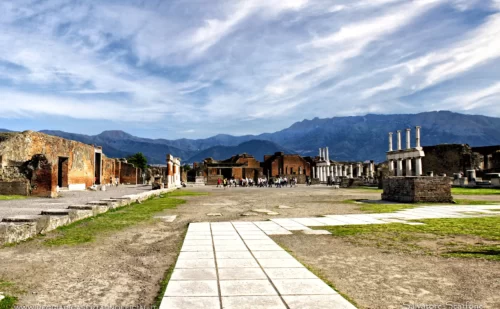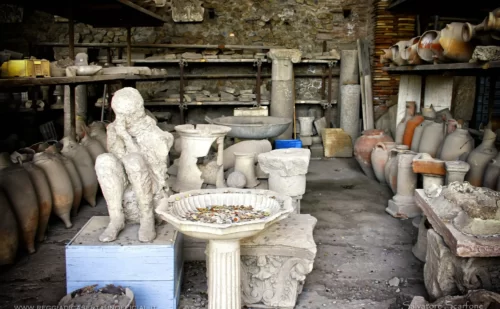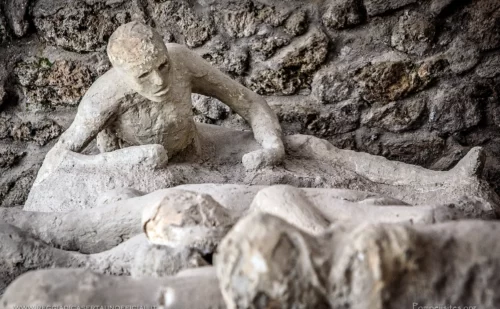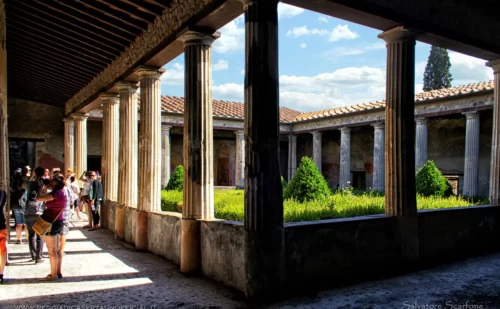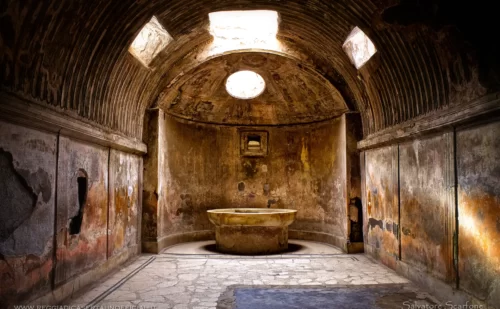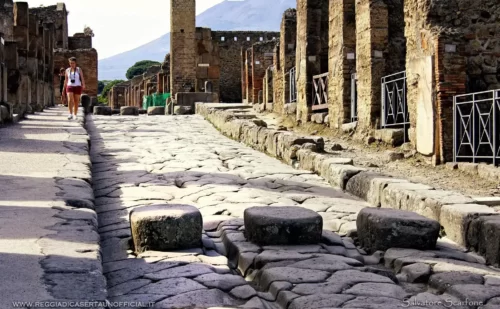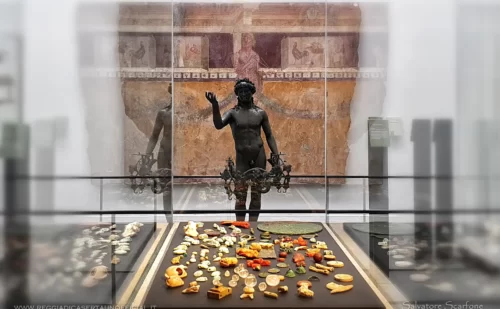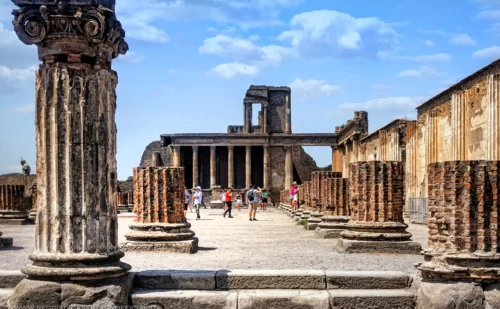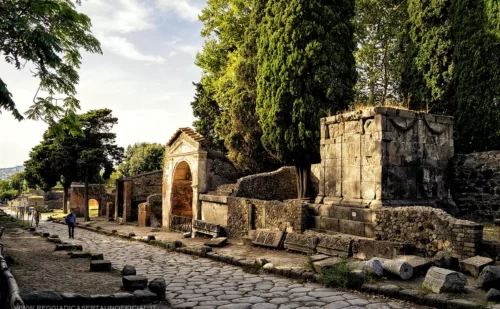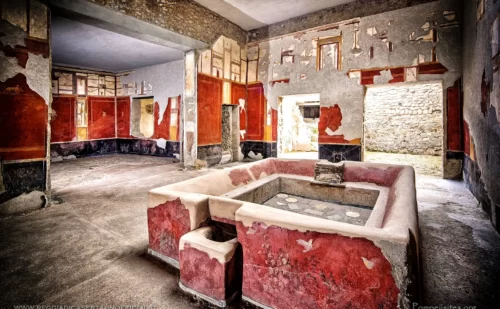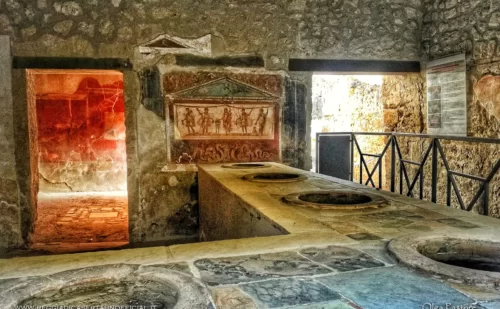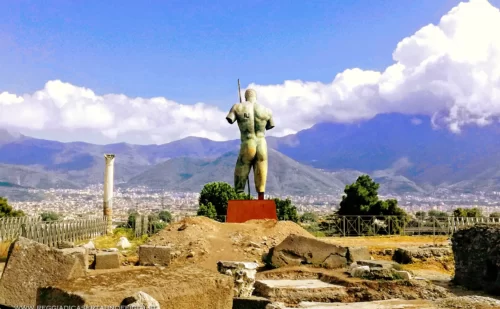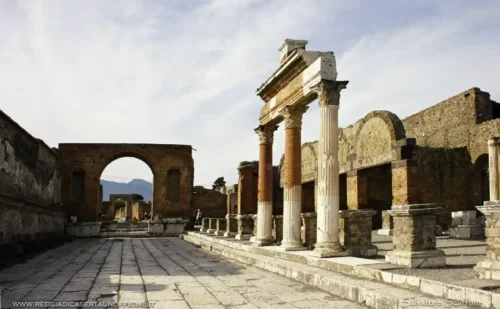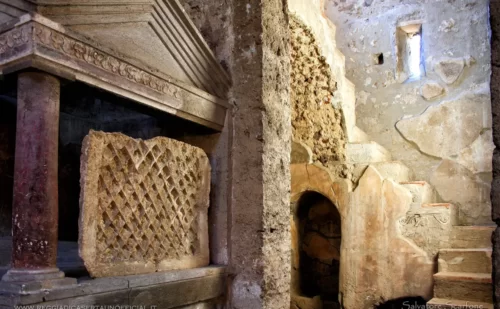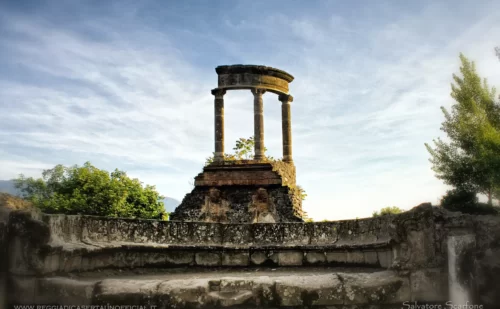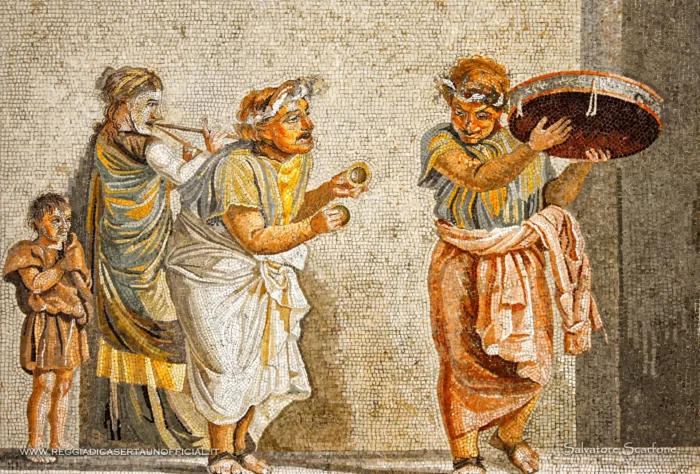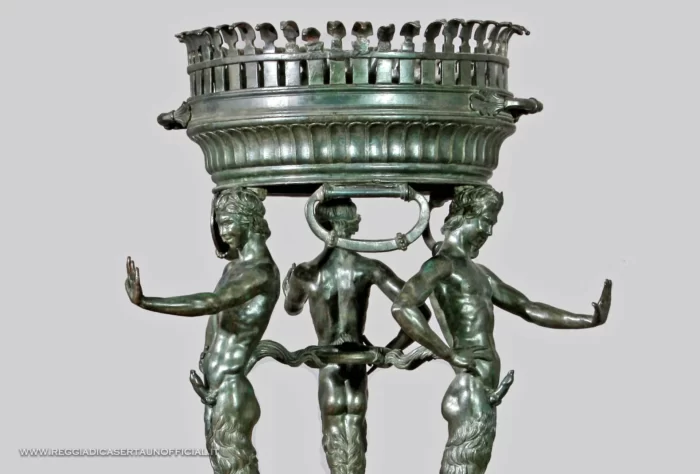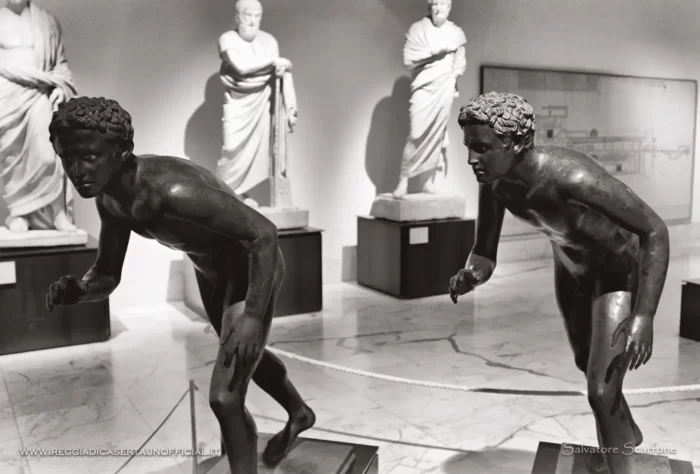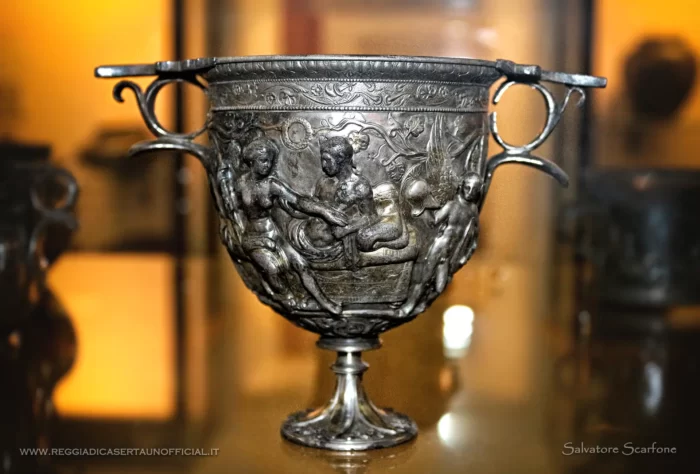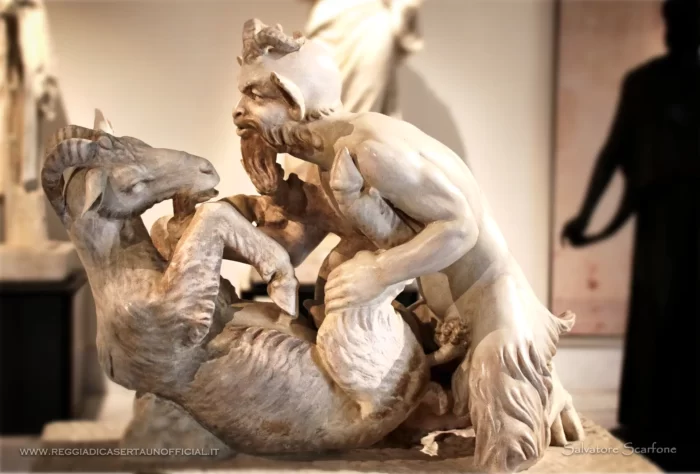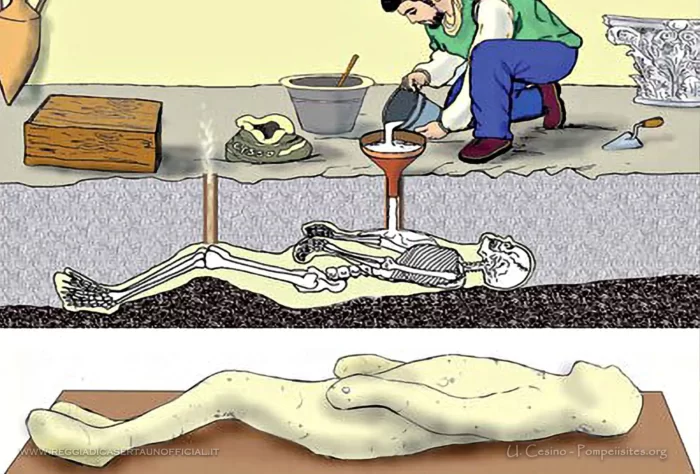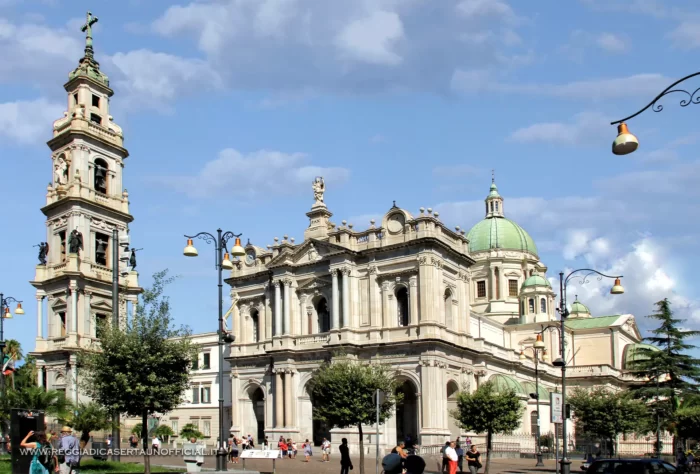The ancient city of Pompeii
Find out what to see in the archaeological excavations of ancient Pompeii and how to organize your visit
A Unesco World Heritage Site, the city of Pompeii is unique in the history of archeology, both for the extraordinary conservation of the city and for showing us the cross-section of life in a Roman city 2000 years ago.
The attractions of Pompeii: what to see
Pompeii is certainly the best-known archaeological site in the world, as the crowds of its visitors attest to every day: this universal fame practically begins at the very moment of its discovery, in the mid-18th century, and whose excavations were commissioned by King Charles of Bourbon.
Destroyed in 79 AD. from an eruption of Vesuvius, this has allowed us to give us back an intact cross-section of Roman civilization, showing us public and private buildings, people’s lives, their tragic deaths. In addition to Pompeii, the cities of Stabiae, Herculaneum and Oplontis were also destroyed.
All the archaeological finds found in Pompeii and Herculaneum are found in the Archaeological Museum of Naples.
The archaeological excavations of Pompeii have the following timetable:
Timetables from April 1st to October 31st:
- 9:00 - 19:00 (9:00am - 7:00pm)
- last admission 5.30pm
Timetables from November 1st to March 31st:
- 9:00am - 5:00pm
- last entry 3:30pm
Gli scavi archeologici di Pompei sono aperti da lunedì a domenica.
Giorni di chiusura: 25 Dicembre, 1 Gennaio e 1 Maggio
The Villa of Mysteries
The Villa dei Misteri in Pompeii owes its name to the wonderful and very famous frescoes from the Hall of the Mysteries of Dionysus. The villa has 90 rooms and roof gardens overlooking the sea and also has an area for the production of wine. The villa is almost completely frescoed.
The grocery store
The Macellum of Pompeii was the place of the city market, where you could buy fresh vegetables, fish and meat. Inside there are shops, sculptures and the walls were decorated both with scenes of daily life, such as the sale of fish and poultry, and with mythological subjects.
The Great Theatre
Comedies and tragedies of the Greco-Roman tradition were performed in the Teatro Grande of Pompeii. It dates back to the middle of the 2nd century BC. but it was modified in Roman times. An inscription, visible at the entrance to a corridor, bears, a very rare thing, the name of the Roman architect Marcus Artorius Primus who carried out work on the stage, added the numbers to the seats, and inserted the velarium, a gigantic cloth placed on top to shade in summer.
The quadriportico of the theatres
The Quadriportico dei Teatri is located next to the theater and was the foyer where the public stopped during breaks in the shows. After the earthquake of 62 AD it became a barracks for the gladiators and, probably, the lanista, their owner, also lived on the upper floor. During the excavations many parade weapons, many victims and also a large amount of jewels were found.
The Odeion (small theatre)
The Odeion of Pompeii was a small covered theater renowned for its perfect acoustics. It was built by the same people who financed the construction of the amphitheater, and internally it was very rich in marble and sculptures. It was mainly used for the representation of the most popular theatrical genre at the time, the mime.
The Temple of Isis
The Temple of Isis when it was discovered was almost intact in decoration and furnishings, and contributed decisively to making Pompeii known throughout the world. It was linked to the mystery cult of the Egyptian goddess Isis, and even the water of the Nile was contained in the basement. Mozart visited Pompeii in 1770, and was so impressed that he used it for the sets of the first performance of the “Magic Flute” in Vienna, in 1791.
The House of the Faun
The Casa del Fauno owes its name to the small and wonderful bronze statue at the entrance. Already from the majestic entrance door with its inlaid marble floor it is clear that it is a huge house (3000 square meters) and that the owner was a person of great taste and very rich. The house has two peristyles and two atriums, and the famous Alexander mosaic was a floor in the house.
The House of the Vettii
The Casa dei Vettii is one of the most luxurious in Pompeii, and was owned by the Vettii family. Very famous is the fresco of the entrance, where you can see the god Priapus weighing his enormous phallus on the scales. Also equipped with a large garden full of jets and sculptures, the house is richly frescoed also with an erotic theme.
The Amphitheater of Pompeii
The amphitheater of Pompeii dates back to 70 BC. it is the oldest in the Roman world and welcomed up to 20,000 spectators. A double external staircase leads to the upper floors, while a corridor leads to the lower ones. Tacitus recounts that in 59 AD. there was a bloody brawl between the spectators of Pompeii and Nocera, and the Senate of Rome ordered the Pompeii arena to be closed for ten years, but the provision was canceled three years later following the earthquake that struck the city.
The Great Gym
The Palestra Grande of Pompeii is a large square square of 140x140m with a large swimming pool in the center, and is surrounded by arcades. The Palaestra is located next to the amphitheater and was used for the physical and intellectual training of young people. Today it houses permanent and temporary exhibitions.
The Lupanare (a brothel)
In Pompeii there were 25 brothels (lupanari) and the prostitutes were slaves, and cost 2-16 assi (a cup of wine cost one). The building has two floors: the prostitutes lived above, while below they worked. There are 5 small rooms with built-in beds, which were furnished with mattresses and curtains to make them more comfortable. Above each door there is an erotic fresco that served as a reminder of the position to be taken during intercourse, and the particularity is the depiction of an aristocratic environment to give customers the illusion of being part of that world. Under the stairs there was a small latrine.
The Sanctuary of Apollo
The Sanctuary of Apollo is located next to the Piazza del Foro and is the oldest sacred building in Pompeii, and reminds us of the Greek origins of the city, which date this temple to the 6th century BC. A monumental colonnade perhaps equipped with a terrace connected the sanctuary to the Piazza del Foro. Here the gladiatorial games and the Ludi Apollinares took place, the festivals in honor of the god with the initiations of children to Apollo and Diana.
The Forum of Pompeii
The political and judicial life of Pompeii took place in the Forum, which also housed the city’s public administration buildings, commercial activities and the main places of worship. Initially it had a trapezoidal shape in the direction of Vesuvius, it was later modified as it appears today, rectangular in shape, paved and surrounded by two-story porticoes and monumental buildings were added. Already in antiquity the Forum became a place of looting of the pavement, of the marbles of the bases of the statues, as well as of the statues themselves, etc. Not counting the damage in 1943 following the bombing of the United States.
The barns of the hole
The Granaries of Pompeii are located on one side of the Forum, and were used for the fruit and vegetable market. Since the end of the 19th century they have been used as a storehouse for the objects of Pompeii’s daily life: pots and stoves for cooking, jugs and bottles, and amphorae for oil, wine and fish sauces, marble fountains which decorated the entrances of the houses and some casts of victims of the eruption, a dog and a tree.
The Temple of Jupiter
The Temple of Jupiter dominates one side of the Forum, and Vesuvius rises spectacularly behind it. It was later modified and became a Capitolium, i.e. a temple dedicated to the Capitoline trinity of Jupiter, Juno and Minerva. The new interventions enlarged the cell of the temple, which was equipped with a rich mosaic floor. On the podium are the favissae, underground rooms originally intended to receive offerings to the gods but which, perhaps, guarded the city’s public treasury.
The Garden of the Fugitives
The Orto dei Fuggiaschi is a very touching place in Pompeii, as there are still the bodies of 13 victims of the eruption. The victims were in a vineyard and were looking for an escape route but everything was already covered in 3.5m of pumice. Then they were all killed by a 500-900 degree pyroclastic flow which suffocated and burned them.
The House of Menander
The Casa del Menandro in Pompeii was a small oasis of peace within the city. The atrium is frescoed with scenes from the Iliad and the Odyssey, and even had private baths. Under the baths there is a cellar where a house was found with over one hundred pieces of silver pottery, now exhibited in the Archaeological Museum of Naples. The house takes its name from the fresco with the portrait of Menander, a playwright from Athens, but it was owned by relatives of the Empress Poppea, Nero’s wife.
The thermal baths
In Pompeii there were 4 public baths: the forum baths, the stabian baths, the central baths and the suburban baths. Each was equipped with hot and cold environments, and some also had an external gym surrounded by a portico. The rooms were heated by double floors which circulated the hot air coming from the furnaces and mobile braziers. Men and women had separate rooms. The Stabiane baths, from the 2nd century BC, are among the oldest known in the Roman world.
Via dell’Abbondanza
The Via dell’Abbondanza of Pompeii was the main road of the city, and also leading to the Forum, it was very busy, therefore there were many thermopoliums, small take-away taverns. On the walls of the houses in Via dell’Abbondanza there are many electoral, advertising, offensive, etc. inscriptions.
The Antiquarium of Pompeii
The Antiquarium of Pompeii was born in 1873 thanks to Giuseppe Fiorelli to exhibit finds of the daily life of ancient Pompeii and the casts of the victims of the eruption. Today not only does it tell the story of Pompeii from the Samnite age (4th century BC) up to the tragic eruption of 79 AD, but it also exhibits precious collections of the immense Pompeian heritage, including the latest discoveries made during the current excavations. All the other finds are in Naples in the Archaeological Museum.
The Pompeian Basilica
The Basilica of Pompeii is 1500 square meters large, it was the most sumptuous building in the Forum. It had various functions divided between two floors: various commercial activities, “chamber of commerce”, court and, probably, it was used as a forum in winter. The Basilica dates back to 130-120 BC. and is one of the oldest examples of this type of building in the entire Roman world.
The necropolis
Pompeii has two necropolises and various funerary structures. They are placed in the access roads to the city of Porta Ercolano and Porta Nocera both for a display and richness of the most important families, and a profound vision of the meaning of life in demonstrating the transience of mortal life. However, it should not be forgotten that those areas were also places of occasional encounters with prostitutes. The fascinating aspect of the necropolis has given, also thanks to Goethe, a great contribution to the birth of Neoclassicism.
Stephanus' Fullonica
The so-called fullonicas were the laundries of Pompeii. Here the dirty laundry was washed by the slaves who pounded the clothes in large tubs, and urine was also added inside, as it was rich in ammonia, which was collected in pots placed along the streets. The skeleton of Stephanus, the owner, was found with a hoard of gold coins.
Thermopolis
The thermopolises were small cafeterias scattered throughout Pompeii. There were about 90 of them, and the ones with the highest takings are even frescoed like the villas of the Roman patricians. In this place drinks and hot food were served, which were stored in large jars built into the counter. Very rich was Vetutius Placidus, who, despite his humble origins, was so successful that he could afford a house entirely frescoed, and under the counter of his thermopolyum the day’s collection of 3kg of coins was found.
The Sanctuary of Venus
The Sanctuary of Venus is dedicated to the patron goddess of the city. Located in a scenic position overlooking the sea from which it was possible to see the port. At the time of the eruption they were still rebuilding the temple destroyed by the earthquake 17 years earlier. In the 19th century, a large golden lamp, a gift from the emperor Nero, was found inside a temporary altar.
Photos
Some photos of Pompeii
The archaeological finds of Pompeii and Herculaneum
All the fabulous treasures, statues, objects, mosaics and frescoes of Pompeii and Herculaneum can be visited in the Archaeological Museum of Naples.
The casts of the bodies
Those plaster bodies you see are not fake, but inside they contain the skeletons of the victims. When Pompeii was covered in ash, so were the bodies. With the strong pressure of the upper deposits, the ash compressed, and after the bodies decomposed, they left their imprint in the ash. In 1863 Giuseppe Fiorelli had the idea of filling the cavities with plaster, so now we can see all the crudeness of the reconstructed bodies with the skeleton still inside, and even with the facial expressions of the pain felt by the victim still visible.
The Sanctuary of the Blessed Virgin of the Rosary of Pompeii
The city of Pompeii is not only known for its archaeological park, but has been a place of pilgrimage since the end of the 19th century. The Sanctuary of the Blessed Virgin of the Rosary of Pompeii, in fact, attracts 4 million faithful from Italy and abroad every year, and was commissioned in 1883 by Blessed Bartolo Longo. Numerous miracles are attributed to the painting of the Madonna of Pompeii, a seventeenth-century work probably by Luca Giordano.
Guided visit to Pompeii
Do you want to visit Pompeii with a licensed tour guide? Request information about a tour.
This is only a form to request information, it does not imply an automatic reservation.
Activities and what to do in Pompeii
Find out what to do in your visit to Pompeii
DocumentarIES
Find your hotel in Pompeii or in another city
Why wait until the last minute? Search now for your hotel in any city in Italy, Naples, Caserta, Sorrento, Capri etc

